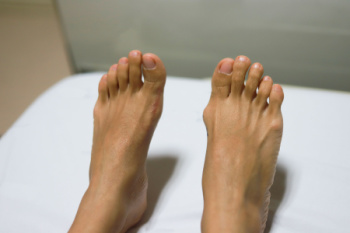
A bunion is a foot deformity where the big toe gradually shifts toward the second toe, typically creating a bony prominence at the base of the big toe. This change in alignment can lead to irritation of the joint, causing pain, redness, and swelling, especially along the inner side of the foot. The joint may become stiff, and fluid-filled sacs called bursae can develop, sometimes leading to inflammation known as bursitis. The discomfort from a bunion may worsen when wearing shoes that lack adequate support or have a narrow toe box. A podiatrist can evaluate the degree of deformity and determine if structural issues in the foot, such as excess pronation or joint instability, are contributing factors. When discomfort interferes with walking or conservative options fail, surgery may be considered to realign the toe and reduce pain. If you are experiencing pain from a bunion, it is suggested that you schedule an appointment with a podiatrist for an exam and appropriate treatment options.
If you are suffering from bunion pain, contact Darlyne Cange, DPM of Cange Podiatry, DPM, PA. Our doctor can provide the care you need to keep you pain-free and on your feet.
What Is a Bunion?
Bunions are painful bony bumps that usually develop on the inside of the foot at the joint of the big toe. As the deformity increases over time, it may become painful to walk and wear shoes. Women are more likely to exacerbate existing bunions since they often wear tight, narrow shoes that shift their toes together. Bunion pain can be relieved by wearing wider shoes with enough room for the toes.
Causes
- Genetics – some people inherit feet that are more prone to bunion development
- Inflammatory Conditions - rheumatoid arthritis and polio may cause bunion development
Symptoms
- Redness and inflammation
- Pain and tenderness
- Callus or corns on the bump
- Restricted motion in the big toe
In order to diagnose your bunion, your podiatrist may ask about your medical history, symptoms, and general health. Your doctor might also order an x-ray to take a closer look at your feet. Nonsurgical treatment options include orthotics, padding, icing, changes in footwear, and medication. If nonsurgical treatments don’t alleviate your bunion pain, surgery may be necessary.
If you have any questions, please feel free to contact our offices located in Glen Burnie and Ellicott City, MD . We offer the newest diagnostic and treatment technologies for all your foot care needs.
